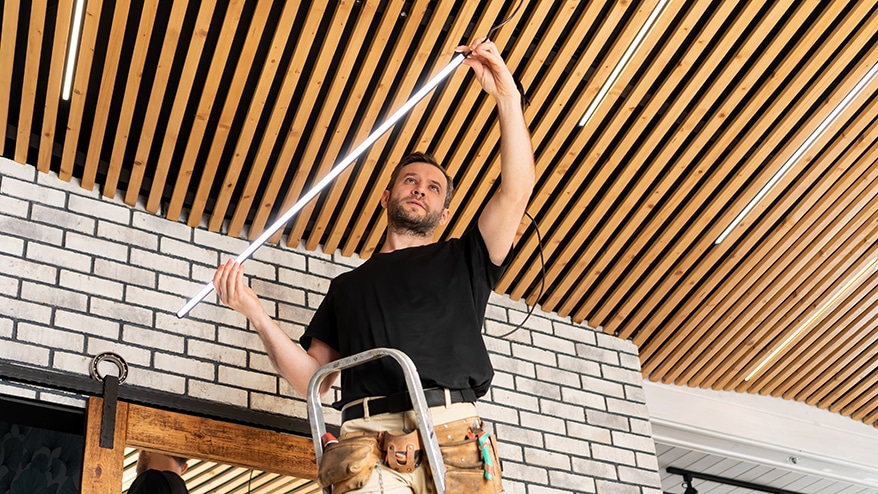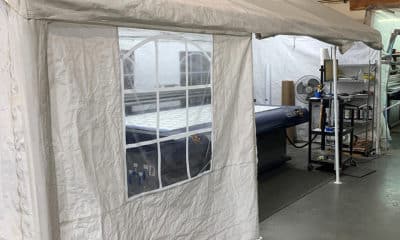WE HAVE COME to rely upon certain types of lighting as a ubiquitous standard, like the screw-in (tungsten or incandescent) light bulb. Today, it’s harder to find an incandescent A19 type lamp on the shelf, if at all. Invariably you’ll find an LED equivalent, with a color temperature around 3000K (tungsten) and with a modest power consumption.
So too is the fluorescent lighting market, seeing seismic changes on the horizon. Europe has enacted a new policy to address toxic mercury found in fluorescent lamps (RoHS = Restriction of Hazardous Substances). Vendors that source fluorescent lamps in Europe have until 2025 to figure out an alternative for their fluorescent lighting customers. New lighting sales in Europe starting late in 2023 will need to be LED and not fluorescent. This does not affect the US market, yet.
It’s clear there’s a move toward LED use in everyday life. Our print viewing conditions need to adapt, as well. New commercial offset printing press installs are already using LED light fixtures at the press console, and it’s been that way for a while now.
The cost of LED ownership and electricity over a decade has proven to provide an economical and ecology benefit. But can the LED offering meet the ISO standard for print evaluation?
ISO 3664:2009 specifies viewing conditions for images on both reflective and transmissive media. ISO 3664:2009 references a standard illuminant of CIE daylight illuminant of D50. This is a theoretical reference and not based upon an actual device. In essence the reference is uncoupled from a device to simulate. Thus LED, tungsten halogen, or fluorescent lamps can all possibly achieve the reference of D50 defined in the ISO standard. That is the beauty of the standard of allowing many technologies to achieve a measurable similarity to a reference. Of course, they will look different because the Spectral Power Distribution (SPD) across a rainbow is different, yet they meet the standard. A Chrysler, Honda, BMW, and Tesla can all achieve 20 mph but certainly drive and feel differently at 20 mph even though the agreement is they are all driving at 20 mph.
Matching a reference illuminant began with tungsten halogen lamps. The output was consistent, once up to temperature, and could be adjusted through filtration to meet a reference illuminant. This was a good start toward having multiple entities evaluate color under the same light conditions, going so far as to list a particular manufacturer as the reference to use in technical documentation.
Advertisement
The look of the filtered tungsten halogen bulb in some ways became a standard for ensuring everyone was evaluating under the same lighting. In the past, energy conservation was not a consideration. Light booths with tungsten halogen lamps required more power, 20 amps, and generated a lot of heat.
Fluorescent lamps offered a less expensive, reduced power consumption, and improved method for meeting the reference CIE illuminant of D50. Through filtration and careful balancing of electrical power (ballast), an improvement to meeting the reference CIE illuminant was attained.
Today, LED is the evolution from historical lighting options. LED lamps are much smaller, emit a higher illuminance, do not get hot, and have a longer life span. It has also proven to be challenging to meet a reference illuminant with a single LED light source. A cluster or pod of different LED lights offers the flexibility in meeting the CRI and SPD needed to match a reference CIE illuminant of D50 or D65. In fact, a pod of LEDs allows many illuminants to be simulated. Other illuminants like U30 and TL84 can also be simulated with LED. Some reference illuminants are more difficult to simulate than others because of the narrow band spectrum of LED.
The future of lighting is clearly LED and there are commercial solutions available today to address ecological, long-term cost of ownership and economical concerns.
As Europe leads the effort to end toxic mercury being used, the USA will eventually follow suit. It’s not a question of if, but when that will happen.


 VEHICLE WRAPS + GRAPHICS3 weeks ago
VEHICLE WRAPS + GRAPHICS3 weeks ago
 Press Releases4 weeks ago
Press Releases4 weeks ago
 Case Studies4 weeks ago
Case Studies4 weeks ago
 Case Studies1 week ago
Case Studies1 week ago
 Benchmarks3 weeks ago
Benchmarks3 weeks ago
 Press Releases2 months ago
Press Releases2 months ago
 Press Releases4 weeks ago
Press Releases4 weeks ago
 Press Releases2 months ago
Press Releases2 months ago


















